Kursk invasion in the Big Picture
When and how, started and planned
On August 6, the Russian Kursk Region came under a massive attack from Ukraine. Armed Forces of Ukraine (AFU) consisting of the 82nd and 80th separate air assault brigades are leading the attacks, supported by the 22nd and 61st separate mechanized brigades of the AFU. In addition, the 150th Motorized Rifle Brigade, 5th Air Assault Brigade, 151st Territorial Defense Battalion and 24th Mountain Assault Brigade are participating in a limited capacity. Moreover, plenty of foreign mercenaries have been detected in assault troops.
It appears that the AFU are using its last reserves to attack the Russian border in the Kursk Region. The Ukrainian losses during the first day amounted to 260 fighters and 50 armored vehicles, including tanks and anti-aircraft missile systems. Western Media was not reporting on a large-scale suicidal Ukrainian cross border incursion but praised “brave AFU invasion”. Ukrainian commanders again put “PR and media optics” ahead of the lives of their soldiers.
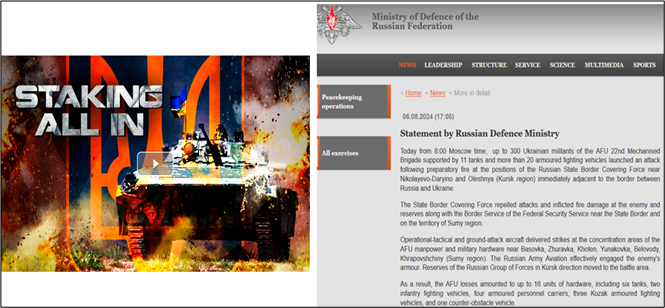
Kyiv Stakes Its All In Kursk Region
South Front video, August 7, 2024
Since the start (August 6), the RuAF and border guards have been destroying Ukrainian formations that infiltrated the region of Kursk. On the other hand, AFU expanded its invasion quite rapidly during the first 5 days.
On its seventh day the Ukrainian army incursion into the Russian Kursk oblast seems to have come to a halt. The front-lines are hardening and the Russian side is using its artillery and bombing predominance to push it back. There are three Ukrainian brigades involved plus a number of battalions that have been dispatched away from their brigades involved in other parts of the front. The 80th and the 82nd paratrooper brigades are the main forces. They have partly been trained in Britain and Germany and are using western equipment. The 22nd mechanized brigade is the third major unit. Then there are some five to ten battalions from various other brigades.
Some aspects of Ukraine’s operation appear to have been meticulously planned. Operational security delivered the element of surprise, a crucial aspect of warfare. “We sent our most combat-ready units to the weakest point on their border,” says a general-staff source of AFU deployed to the region. The operation is now going to resemble a new meat grinder like Krinky on the southern front, into which the Ukrainians will have to feed more and more reserves.
Zelenski believes the Kursk operation would help to keep the war going with Russia failing over time and Ukraine becoming the winner. The Times recently said: President Zelensky’s personal fingerprints are all over it. It’s been an open secret in Kyiv for many months that the president was pressing his military chiefs to launch a summer offensive. Given Ukraine’s manpower and resources problems, they were hesitant. But Zelensky is desperate to reverse the narrative that Ukraine is losing its war.
Considering the AFU invasion, some military experts are reporting that August 12 seems to be a turning point of this invasion: The Ukrainian forces used the same tactical techniques that were utilized in the Kharkiv region in 2022 and by RuAF in 2024 in the same direction.
The main idea was to use NATO satellites and aerial reconnaissance to identify areas with lower density of Russian strong points and forces, then attack with small maneuverable groups, bypass the strong points, eliminate rear supplies and consolidate until the main forces arrived.
Initial attack phase: The first to stand in the AFU’s way were Russian border guards and conscripts, who had only light weapons. The Russian firing positions with machine guns and mortars were identified in advance and massively attacked at night by kamikaze drones and Baba Yaga drones.
Expanding phase: After the drone attack, the AFU’s heavy equipment made corridors in Russian defense, through which the AFU troops and foreign mercenaries entered, dispersing deep in the rear. The AFU used NATO’s electronic warfare and satellite infrastructure, which left many of Russian border guard units without communication and information about what was happening, and not only the units, but also civilians.
Encirclement phase: A significant part of Russian local strongholds was surrounded. The AFU blocked supply routes and critical roads with sabotage groups in advance, which made it difficult for reinforcements and supplies to arrive. There were almost no strongholds or large groups of soldiers around the border villages and towns, which allowed the enemy to freely enter the operational space and spread along the flanks.
Media manipulation: The AFU actively used information and psychological operations to undermine morale and spread panic among the Russian population and soldiers. By publishing photos and reports about allegedly captured territories, Russian major telegram channels picked up these leaks, playing into the hands of the enemy.
Back to basics: Systematic work by RuAF has begun now, in order to squeeze out the enemy. Aviation work to disrupt supplies is carried out around the clock, now FPV drone operators and other specialists are already involved. The main task: cut off supplies and eliminate AFU troops in the region.
There is a lot of criticism in Russia for the lack of preparedness on the Russian side. There is no doubt that the Russian General Command had plenty of notice on Ukrainian preparations but did nothing to counter it or even to prepare to counter an invasion. Part of the reason probably is the heavy focus on major gains, especially in Donbass, by Russian forces, leading to a number of breakthroughs that either have happened or are about to take place.
Reasons behind the Kursk invasion
The basic overview tells that the AFU incursion makes little sense. Russia has available forces in the area and therefore RuAF have no need to stop its attacks in the Donetsk region to counter the Ukrainian forces near Sumy. In 1943, the German attack on Kursk was launched for a similar reason – to divert Russian forces from attacking in the Donetsk region. It ended in utter defeat.
Even many pro-Ukrainian commentators are shocked about this obvious waste of men and resources in strategically near-unworthy region. From AFU point of view, the situation in the Pokrovsk direction is critical, with defenses in several areas collapsed or collapsing, largely due to a shortage of personnel. Diverting experienced brigades to launch an assault on Kursk Oblast, which lacks strategic sense, seems to be fully crazy.

The New York Times tries to make sense of Ukraine’s attack on Kursk Oblast and finds none. The Ukrainian Armed Forces’ attack on the Kursk region is a “brainless plan” by Kyiv and NATO, said former CIA analyst Larry Johnson.
Why would Ukraine be willing to sacrifice so many troops in an operation that will “sooner or later” get rolled up? Here below are some key reasons analyzed:
PR and media optics for raising fighting spirit and morale among the AFU troops and the people. The recent move by Ukraine to take Kursk was bold. It’s hardly surprising that the Western media have blown it up to be bigger than it really is. Taking a small enclave of Kursk is one thing but keepingit is a whole new matter, the real test of the move comes in the days ahead. The map here below reveals the size range and perspective of this incursion operation:
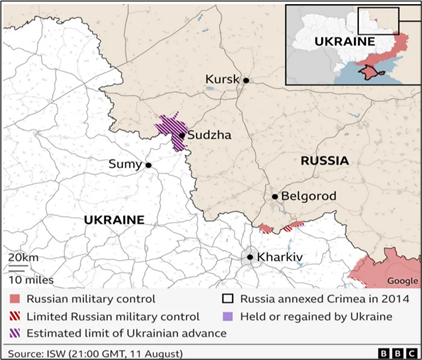
Ukraine’s ability to defend its territory in Donbass is collapsing, as the Russians are carrying out relentless attacks slowly dislodging Ukraine’s defenses, even in built-up towns with high-rise concrete and steel buildings as strong positions for Ukraine’s troops. On a daily basis, Ukraine has been losing around 2,000 troops (killed and wounded) and morale in some brigades has likely gone to near zero. These massive losses are shaking the whole Ukrainian society.
For Western elites to instigate Zelensky on and then congratulate him is both foolish and dangerous. So far, Putin has refused to be baited into a full-out war with NATO but one cannot account on that his patience is unlimited.
Zelensky has taken the Kursk option to try and draw Russian troops out of the Donbas. Militarily, of course, this makes sense and most analysts present this as the main point of the exercise. Politically also, Zelensky knows that the pressure will be on Putin to do something to settle the Kursk issue. Russians did not think, when starting their SMO, that it would spill over into their own country.
The Ukrainian president, for the first time, reached out to Putin and his officials, when he invited Russia to a peace conference in November. Zelensky believes that he needs to make a move before the US elections are over, given that a Trump victory might push him to give up much more than his political expediency will allow. Having Kursk in his war chest will be very useful for the symbolism, as a card to play, when negotiations actually start. Ukraine’s leadership is under considerable Western pressure to negotiate with Russia, something that even President Volodymyr Zelensky has acknowledged. The Kursk offensive can thus be seen as a gamble for Ukraine to have leverage with Russia in a peace negotiation.
Kursk region is mentally, psychologically and historically an extremely sensitive area for Russia. The WWII battle for Kursk was a major turning point for the Soviet Union, leading to the eventual defeat of the Wehrmacht. That battle was one of the costliest fights in WWII and remains today the biggest tank battle in history. If Ukraine can hold Russian territory, perhaps for a few months, they can use it as a trading card with Russia.
There is also another important development which is running concurrent to these events, which is the role that Belarus could play in the coming months. Ukraine has repeatedly operated drones in the country’s airspace and been warned of the consequences. Recently tanks from Belarus were sent to the border, cranking up tensions even more if Ukraine angers Minsk once more.
The strategy and tactics, Ukraine is showing at Kursk, were developed with NATO. It is a test case for the defense of Europe in case of a Russian attack. If fighting were to break out in Poland, or Romania, or north in the Baltics, the Russians would have a significant advantage in ground forces. Ukraine is testing right now such an operation in the Kursk region. One can easily imagine a similar vector in a broader European conflict, perhaps aimed at knocking out Kaliningrad or focused on St Petersburg or even Moscow.
Other possible factors in Ukraine’s operation that may play a role, such as the Sudzha Gas Metering station. The station, located on the Russia-Ukraine border several kilometers from the Russian town of Sudzha, handles all gas flowing from Russia to Europe. Ukraine claims to control the station and there is speculation that Ukraine may decide to blow it up. If that happens, then Europe will have to depend on LNG exports from the United States. Like the overall Kursk operation, the Gas Metering Station is a bargaining card, if Ukraine can hang on to it. If they blow it up, then it becomes an economic issue for Russia and Europe.
Another possible target is the Kursk Nuclear Power plant, which is far deeper inland than the Gas Metering Station. Moreover, any attack on the nuclear power plant could cause a Chernobyl-type disaster that would not help Ukraine’s political position in Europe. Even so, the Ukrainian press is speculating about the fate of the power plant.Among international observers, there are multiple ideas, what the Ukraine leaders wants to achieve with this incursion. One new idea is that the attack was made to unbalance Russia.
Ukraine’s operation has also punctured the Kremlin’s carefully constructed image of Putin as the protector of ordinary Russians. Instead, the war he started in Ukraine now spills increasingly into Russia, where people in border regions live under constant risk of shelling and drones strikes. Much indicates that Kiev’s real strategy is to wage a long war in the hope of internal destabilization in the Russian Federation.
In a recent interview, the head of the Office of the President of Ukraine (and brain behind Zelenski), Andrey Yermak said that he sees no point in direct negotiations with Russia. The plan in Kiev is not to negotiate but to prolong the war and to convince the west to further finance it. This would have the advantage of moving billions of additional dollars from western sources into the various pockets in Kiev with Zelenski and Yermak cashing in the largest share of it.
The big question is whether Ukraine will be successful in the Kursk operation. Much depends on the rapidity of the Russian response and the ability of the Ukrainian forces to dig in and hold ground. This move comes with a high price, which indicates also the level of desperation that Zelensky is in. If Zelensky loses the Kursk patch, then the humiliation and the loss of support from the military and its families will be unprecedented. If Kursk backfires, it might well cost him everything. The risks of course are not only with Zelensky alone but weigh heavily on the West also.
A special target, Kursk NPP
The Ukrainian Armed Forces planned to seize the Kursk Nuclear Power Plant by August 11 but this task was not completed. Akhmat Special Forces Commander Major General Apti Alaudinov confirmed that “as many of us suspected that was the main goal and a target.”

Statement of Commander of the Akhmat special forces, Major General Apty Alaudinov, August 14.
Here below some excerpts from his statement:
The desperation of Ukrainian and NATO authorities is full blown and on display in the Kursk region and the Zaporizhzhya Nuclear Power Plant. The objective of the Ukrainian attack was the Kursk Nuclear Power Plant, which is some 30 kilometers north of Sudzha. In light of today’s Ukrainian drone attack on one of the cooling towers at the Zaporizhzhya Nuclear Power Plant (ZNPP), it is clear the attack in Kursk was part of a broader Ukrainian plan to try to create some negotiating leverage with Russia. That has failed and, in the process of Russia’s counterattack, some of the best remaining Ukrainian brigades are being destroyed.
Ukraine’s Zelensky is moving quickly to try to divert attention from the attack on ZNPP by claiming the Russians did it. Zelensky and the NATO planners, once again, have grossly miscalculated and bet a lot of Ukrainian lives on a half-baked plan. More Ukrainians are going to die because of this insane operation.
Situation Report, NATO involvement
According to ambitious General Commander of the Armed Forces of Ukraine Syrskyi, the Ukrainian military is in control of about 1,000 square kilometers of the Russian territory and the front is about 40 kilometers wide.
The real configuration of the frontlines in the Kursk region is covered by the smog of war. Main forces of the Ukrainian grouping operating in Russia were stopped by Russian border guards and military personnel deployed in the border areas. Soon, Russian military reserves hastily transferred to the border areas, including Chechen special forces and Wagner fighters, stabilized the frontlines and Russian forces are already launching counterattacks grinding Ukrainian units. The latest RMOD report per August 17, is available here below:
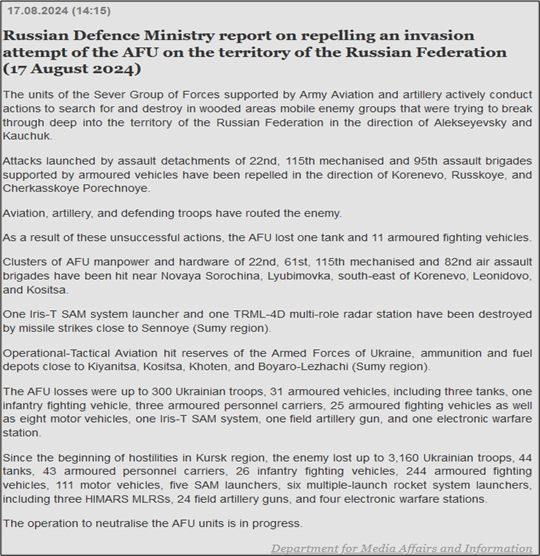
Mikael Valtersson, the Swedish military analyst, has made top military analyses regarding AFU’s Kursk incursion. Here below some links:
Another quality info source is Military Summary, links here:
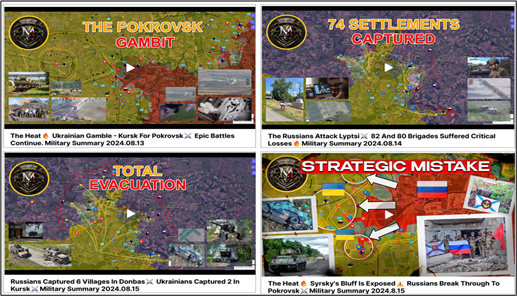
The Heat🔥 Ukrainian Gamble – Kursk For Pokrovsk⚔️ Epic Battles Continue. Military Summary 2024.08.13
The Russians Attack Lyptsi⚔️ 82 And 80 Brigades Suffered Critical Losses🔥Military Summary 2024.08.14
Russians Captured 6 Villages In Donbas⚔️ Ukrainians Captured 2 In Kursk⚔️Military Summary 2024.08.15
The Heat🔥 Syrsky’s Bluff Is Exposed⚠️ Russians Break Through To Pokrovsk⚔️Military Summary 2024.8.15
Now, it seems quite clear that the military situation is the following on August 16: AFU’s incursion in Kursk region has stalled and RuAF troops have started counter-attacks. On the other hand, AFU frontlines in many Donbass regions are collapsing, particularly in Pokrovsk and Niu-york. The high-risk gambling, which Zelensky & Syrskyi began to play, is now backfiring. It seems to be a strategic mistake for Ukraine to divert its best troops and equipment to invade territory it cannot keep. Was it the decision of Kiev or Washington to invade Kursk?
NATO’s role in this incursion
It appears more and more obvious that it was a NATO Operation all along. The planning and coordination are based entirely on American and British intelligence and space – battlefield communication and other electronic facilities. The latest reports from the battlefield at Kursk are telling that 120 French, 180 Polish and dozens of British, Estonian and other foreign troops from NATO countries have been identified. It appears that the entire operation was prepared abroad. Moreover, the US, UK and Germany are taking off all the previous restrictions regarding long-range missiles and rockets enabling the deep strikes in Russia.
The Ukrainian invasion into Kursk is turning out to be a great opportunity for Russia. Destroying the Ukrainian invaders is not the main priority but dragging more Western resources into a place, where they can be easily destroyed. Russia’s enemy in this war is not Ukraine but NATO. Russia is weakening NATO by destroying NATO weapons and resources.
NATO allies now consider it unlikely that Ukrainian forces will be able to hold onto Russian territory — even if it takes Moscow weeks to push them out of Kursk, the western official said. But in any case, the war has already taken on new escalation cycle.
I have studied this topic – NATO’s involvement in Ukraine war – in numerous articles on my website, the latest of August 8, July 15, June 6.
Outcome, ramifications
Fighting in the Kursk region has been ongoing for more than two weeks. The Ukrainian offensive in Russia is a risky bet that pursues mainly political and media goals, rather than military ones. After the Ukrainian army gained a foothold, Ukrainian propaganda and political leadership enter the battle to achieve the largest possible media publicity.
One of the main problems for Kyiv is that it has lost its victim game. Despite the decade-long attempts by the western MSM to brainwash the public, large-scale attacks on the Russian border using NATO military equipment and foreign troops, have destroyed the myth of Ukraine as a victim. Kyiv has turned into an aggressor and the facts confirm numerous war crimes committed by the Ukrainian military in the occupied Russian settlements. The captured Ukrainian servicemen confirm their crimes.
The situation in the Kursk region remains tense but Russian reinforcements managed to stop the advance of Ukrainian troops and inflict heavy losses on the AFU, as stated above. At the same time, the pace of the Russian offensive increased in the Donbass.
Over the past few days, Russian troops have achieved new gains in the Pokrovsk, Toretsk, Ugledar, Chasov Yar and Kharkiv directions.
One ramification is very clear: NO PEACE TALKS. Only a military solution is possible from this on.
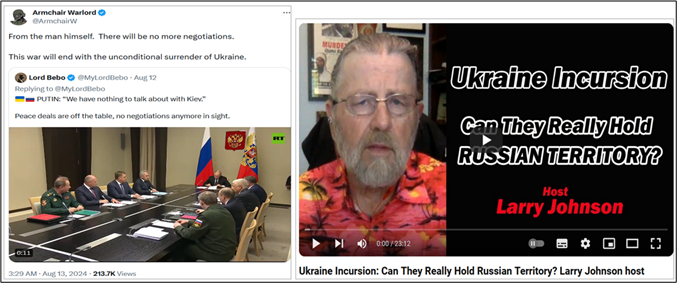
Ukraine Incursion: Can They Really Hold Russian Territory? Larry Johnson host
Daniel Davis / Deep Dive, August 16, 2024
Washington considers options to replace Volodymyr Zelensky as President of Ukraine. The US leadership is allegedly dissatisfied with the actions of the current leader of the country. According to the press bureau of the Foreign Intelligence Service (SVR) of Russia, the US wants to see a more manageable and less corrupt figure in his place. The entire American elite is in favor of a change of power in Ukraine. Former Minister of Internal Affairs of Ukraine Arsen Avakov is one of the candidates for the post of head of Ukraine.
The scenario for Avakov’s rise to power is already being discussed with the leaders of Ukrainian opposition parties such as Yulia Tymoshenko’s Batkivshchyna and Petro Poroshenko’s European Solidarity. In addition, influential deputies of the Verkhovna Rada from Zelensky’s ruling party Servant of the People are also involved in those discussions.
Avakov has established ties with Ukrainian nationalist groups. He also maintained relatively close contacts with the leaders of European countries. The White House calls a change of power in Ukraine an opportunity to better prepare for the possible start of negotiations with Russia to resolve the conflict in Ukraine.
According to a Bloomberg report on Ukraine’s Incursion in Kursk, Ukraine allegedly planned an incursion to “unsettle the Kremlin,”. However, this move may leave Ukraine itself more vulnerable. Various plans were discussed for an extended period before the operation and were known in the West. However, the actual incursion into Kursk caught both the West and Moscow by surprise. NATO allies now doubt that Ukrainian forces can hold onto Russian territory, even if it takes Moscow weeks to push them out of Kursk, according to the official. Nonetheless, the war has already escalated to a new level.
On August 14, Fitch Ratings declared Ukraine bankrupt, following S&P, and doomed Ukraine to long investment crisis. Kyiv’s assets will be sold off by “vulture funds”. Now Kyiv will only be given loans for the war. Private investors have lost their money and will not take any more risks. Fitch Ratings downgrades Ukraine’s rating to RD — “limited default”. The downgrade of Ukraine’s long-term rating from C to RD (‘default imminent’) is due to the expiration of the 10-day grace period for coupon payments on the $750 million 2026 Eurobonds. The rating of these bonds was downgraded to default ‘D’, while the rating of other foreign currency bonds was affirmed at ‘C’. Fitch has withdrawn the ratings of Ukraine’s foreign currency bond issues as they are no longer considered relevant to the agency’s coverage.
Thus, Ukraine is entering a long-term investment crisis, which will not allow the country to attract financing. Western investors start to realize that Kyiv will not be able to repay its debt on loans. In such a situation, Ukraine will have to resell its sovereign debt to “vulture funds” that have ruined quite a few Latin American countries. Ukrainian assets will be sold at a price several times below their nominal value.
Latest situation and professional assessment of the war is available in links below:
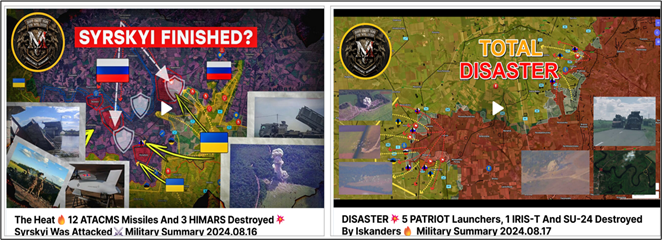
The Heat🔥12 ATACMS Missiles And 3 HIMARS Destroyed💥Syrskyi Was Attacked⚔️Military Summary 2024.08.16
DISASTER💥5 PATRIOT Launchers, 1 IRIS-T And SU-24 Destroyed By Iskanders🔥 Military Summary 2024.08.17
Closing words
“The end is near and so they face the final curtain …”


